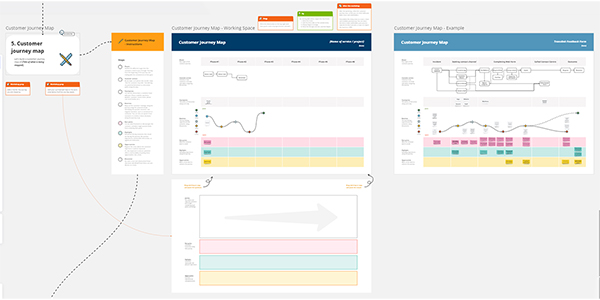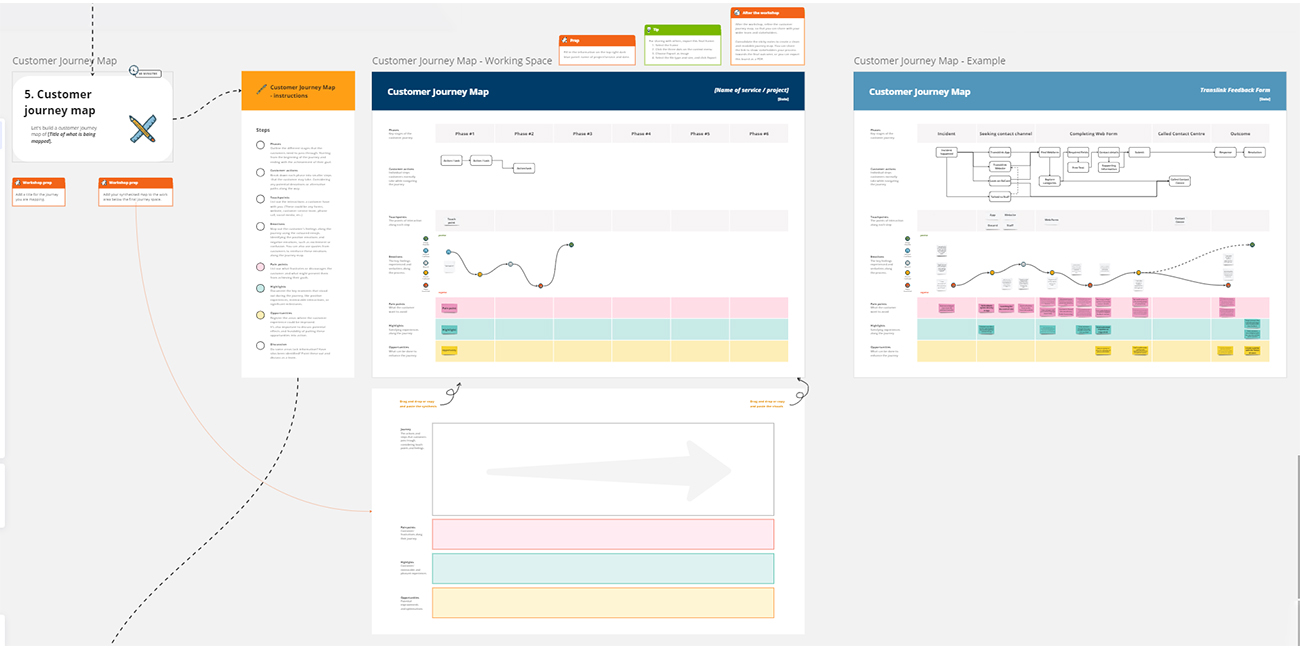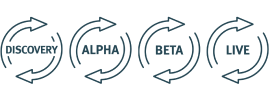Customer journey mapping
A customer journey map is a tool used to understand your customer's experience as they interact with a product or service. It focuses on the customer's perspective and helps you identify pain points in their journey. A customer journey map primarily aims to gain a deeper understanding of their experience, including feelings, while using a product or service.
By creating a visual representation of the customer's experience, journey maps help organisations understand the steps customers take when interacting with their products or services. By considering different types of customers and their needs, journey maps provide a comprehensive understanding of the customer experience. They identify touchpoints, pain points, and needs at each stage of the journey, allowing organisations to identify opportunities for improvement. Journey maps also help map out micro-journeys within each stage, giving a more detailed understanding of the customer experience.
You can use customer journey mapping to:
- Visualise insights around customer needs and expectations
- Identify and address pain points in the customer journey
- Improve customer satisfaction and loyalty
- Increase efficiency and effectiveness in service delivery
- Foster collaboration and communication across teams and departments
- Identify opportunities for innovation and service improvements
Play benefits:
- Enhanced understanding of the customer experience and customer needs
- Increased efficiency and effectiveness in delivering customer service
- Improved communication and collaboration across teams and departments
- Identification of opportunities for innovation

Outcomes
- A draft customer journey map to be refined.
- Identification of customer pain points and areas for improvement in the customer journey.
- A holistic, high-level representation of a user experience, including their feelings, across their touchpoints throughout a service.
What you need
| Remote | In-person |
|---|---|
|
|
Instructions
Customer journey mapping can sometimes be challenging to fit into a timed workshop because the scope of the project and the complexity of the customer journey can vary widely. For example, a journey map for a simple product may be relatively straightforward and require less time than a journey map for a complex service or a long-term relationship.
The scope of the project can also impact the level of detail included in the journey map. It can sometimes be difficult to fit customer journey mapping into a single workshop without sacrificing important details or oversimplifying the process. To address this, it might be necessary to break the process into multiple sessions.
Tip
If you need more information or support to estimating and managing the efforts needed for this play. Feel free to contact us.
Collect evidence from customers
Before you use this play, you will need to make sure you have done the appropriate user research that you will base your customer journey map on. The customer journey map is meant to be supported by evidence, not assumptions.
User research is a critical step before creating a customer journey map because it provides a solid foundation of understanding about the users connected to a service. Here are some key reasons why user research is essential before creating a service blueprint:
- User research will represent users much more accurately when mapping a service, than by basing it on your team’s assumptions.
- User research can uncover pain points or areas where users may face challenges or frustrations with an existing service. Understanding these pain points early on can help you address them in your project, resulting in an improved service experience and higher user satisfaction.
- User research reduces the risk of creating inaccurate or ineffective customer journey maps, saving time, effort, and resources.
- By basing your customer journey map on user research, you can create holistic service solutions with maximum impact for your target users while also considering organisational stakeholders, systems, and processes.
There are many ways to collect the evidence you need around a target user. Desktop research and user research planning are two useful plays to get a clear plan around what you need to explore and what types of users you need to understand further. Our user interview template can also assist in gathering the information you need to get started with a customer journey map.
Synthetic users vs real users
You might have heard of something called “synthetic users” - a synthetic user is an artificial representation (also known as bots or automated scripts) of a user that is created for various purposes, such as user testing or user research.
We strongly oppose the use of synthetic users because they do not fully replicate the complexity of real human users. Real users can have diverse characteristics, behaviours, preferences, and experiences that cannot be accurately captured by synthetic users. This can lead to incomplete or biased results when conducting research, as the nuances of real human behaviour and interaction will be missed.
To be certain you have collected information that will help create true value for your customers, you will need to engage with real people from the Australian population.
Current or future state?
Are you mapping the current state or potential future state? A current state journey map gives insight into an existing service, while a future state journey map gives you the opportunity to explore and innovate future services that do not currently exist.
Mapping the current state is a great place to start if there is misalignment on what the existing process is, or if there are gaps in your knowledge about how customers experience the process. A customer journey map can be a great tool to create a common understanding of what a process is.
If the service already exists, you need to make a current state journey map before making a future state, even if your focus is on the future.
Invite your participants
Participants in this session should be made up of the project team. You’ll want to make sure when you send an invite for the session, that you clearly explain the goal, how long it’ll take, and why people’s participation will be beneficial.
Here is a calendar invitation template to give your attendees an idea of what to expect.
Subject:
Join us for a customer journey mapping session for [project name]
Meeting description:
Hi
As part of our ongoing work for
In this session, we'll collaboratively work through stages to create a draft of the customer journey map, which will then be refined throughout the project. There is no preparation required on your end for this workshop.
The session will be recorded so we can refer back to any discussions for notes if required. If you do not consent to being recorded, please respond by email to let me know.
I appreciate your contribution to the session.
Kind Regards,
[Facilitator name]
1.Introduction – 5 mins
Introduce the session agenda, project purpose and benefits of the play.
2. Walkthrough - 10 mins
Walk the participants through the Miro slides and customer journey map example to show how it works and how they can interact with each step.
After the walkthrough is completed, it is a good idea to see if anyone has any questions for elements which need clarifying.
3. Customer insights
Using the customer evidence previous collected, draft each of your customers’ individual experience journeys.
Extract the content from your customer interview notes into the miro board and add meta-data tags to the customer data to help identify any patterns during synthesis. Create one journey per customer interviewed, to provide a stronger and more comprehensive narrative for your journey map.
For the individual journeys you must delineate phases and actions the customer takes, from start to end of journey, as well as identify any pain points, highlights and opportunities captured from your interviews.
4. Synthesis – 30 mins total
During this stage you’ll start to map a unified customer journey, by merging the previously collected insights into similar groups and identifying patterns in your delivery process.
4a. Copy and paste the customer insights from the previous activity – 0 mins
4b. Group insights – 15 mins
Examine sticky notes from the customer interviews and group them into the sections shown in the work area to the right: journey, pain points, highlights, and opportunities
4c. Discuss and adjust – 15 mins
Discuss groupings that are being made, and consider if themes are appropriate and if sticky notes are in the right groups. Adjust if necessary - often the themes and phases emerge during synthesis.
--- If you are running this play as a workshop, take a five-minute break here---
5. Customer journey map – 60 mins
Time to draft your customer journey map based on the user research data you synthesised earlier – this maps a series of steps the customer takes in chronological order. Before listing all the customer actions, it can be useful to start with larger phases, where a group of actions happens. Examples of this could be the “information-seeking phase” or “transaction phase”.
When you have the phases listed, you can start looking at which activities are linked to each group. Make sure that the phases and actions are added in chronological order. This way you will be able to connect the actions to create a user flow. You may need to have more than one path for the customer journey or there may be loops back to earlier steps or phases.
If you’re mapping the customer journey as a team
As a team, you will first need to map the customer journey by plotting the phases and actions that the customers will take in chronological order. The ‘customer journey’ row is labelled on the Miro template and has sticky notes populated for you.
Start asking the team to call out what should be entered into each step. Start by asking ‘So what action does the customer take first?’. Once you have the first step ask the team what the next step would be. It’s okay if 1 step is missed, the sticky notes can be easily moved around to make room for a step or two the team didn’t consider.
5a. Phases
Outline the different stages that the customers need to pass through. Starting from the beginning of the journey and ending with the achievement of their goal.
5b. Customer actions
Break down each phase into smaller steps that the customer may take. Considering any potential deviations or alternative paths along the way.
5c. Touchpoints
List out the interactions a customer has with you. (These could be any forms, websites, customer service team, phone call, social media, etc.)
5d. Emotions
Map out the customer's feelings along the journey using coloured emojis. Identifying positive emotions and negative emotions, such as excitement or confusion. You can also use quotes from customers to reinforce these emotions along the journey map.
5e. Pain points
List out what frustrates or discourages the customer and what might prevent them from achieving their goals. Place these pain points when and where they occur on the journey – is there a particularly difficult area?
5f. Highlights
Document the key moments that stood out during the journey, like positive experiences, memorable interactions, or significant milestones.
5g. Opportunities
Register the areas where the customer experience could be improved.
It's also important to discuss the potential effects and feasibility of putting these opportunities into action.
5h. Discussion
Do some areas lack information? Have silos been identified? Point these out and discuss them as a team.
6. Wrap up – 5 mins
Thank everyone for their time. Let them know what to expect next.
Use this time to document any final questions or thoughts with the participants.
Here are some follow-up email templates to give your attendees if you would like:
Follow-up email for customer journey mapping
Subject:
Thanks for contributing to the customer journey mapping session for [project name]
Meeting description:
Hi [team name if sending a group invitation, or participant name if sending individual invitations],
Thank you for your participation in creating the customer journey map for the [project name] project.
(If session was recorded) You can access the recording of the session here: [add the link to your recording] if you would like to review any details. Additionally, the Miro link will remain available for 1-2 days if you have any further contributions to make. [add the link to your Miro board].
We will keep you informed about any upcoming steps or updates regarding the project.
Kind Regards,
[Facilitator name]
Feedback email for customer journey mapping
Subject:
Feedback on the customer journey mapping session for [project name]
Meeting description:
Hi [team name if sending a group invitation, or participant name if sending individual invitations],
We have recently completed a customer journey mapping session for [project name] and would like to ask for your feedback.
The current version is in [Miro/Whiteboard] and can be accessed using this link.
Please let us know if you have any questions about the work that has been done so far.
Kind Regards,
[Facilitator name]
Now that you finished your customer journey map, you can delve deeper by doing the service blueprint, play to visualise your service delivery and its underlying resources and business processes.
Resources
See below for a collection of templates and other pages which will help you run this play. These resources are also linked in the play instructions.
Subject:
Thanks for contributing to the customer journey mapping session for [project name]
Meeting description:
Hi [team name if sending a group invitation, or participant name if sending individual invitations],
Thank you for your participation in creating the customer journey map for the [project name] project.
(If the session was recorded) You can access the recording of the session here: [add the link to your recording] if you would like to review any details. Additionally, the Miro link will remain available for 1-2 days if you have any further contributions to make. [add the link to your Miro board].
We will keep you informed about any upcoming steps or updates regarding the project.
Kind Regards,
[Facilitator name]
Subject:
Thanks for contributing to the customer journey mapping session for [project name]
Meeting description:
Hi [team name if sending a group invitation, or participant name if sending individual invitations],
Thank you for your participation in creating the customer journey map for the [project name] project.
(If the session was recorded) You can access the recording of the session here: [add the link to your recording] if you would like to review any details. Additionally, the Miro link will remain available for 1-2 days if you have any further contributions to make. [add the link to your Miro board].
We will keep you informed about any upcoming steps or updates regarding the project.
Kind Regards,
[Facilitator name]
Subject:
Feedback on the customer journey mapping session for [project name]
Meeting description:
Hi [team name if sending a group invitation, or participant name if sending individual invitations],
We have recently completed a customer journey mapping session for [project Name] and would like to ask for your feedback.
The current version is in [Miro/Whiteboard] and can be accessed using this link.
Please let us know if you have any questions about the work that has been done so far.
Kind Regards,
[Facilitator name]

